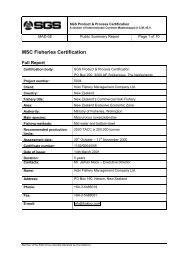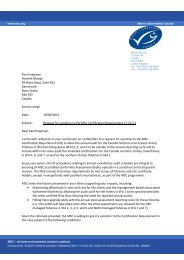SGS Product & Process Certification - Marine Stewardship Council
SGS Product & Process Certification - Marine Stewardship Council
SGS Product & Process Certification - Marine Stewardship Council
You also want an ePaper? Increase the reach of your titles
YUMPU automatically turns print PDFs into web optimized ePapers that Google loves.
Figure 2.Main migration routes of adult sea bass and proposed ‗stock‘ areas within which<br />
fishery and biological data could be used in assessments of bass populations and for which<br />
management advice may be given (ICES 2005). The North Sea stock is designated by the<br />
hatched area ―A‖, the distribution of which now extends into Norwegian and Scottish waters.<br />
Spawning<br />
Tagging studies around England and Wales in the late 1970s and early 1980s demonstrated<br />
that adult bass migrated between feeding areas in the North Sea and pre-spawning and<br />
spawning areas which tended to be offshore in western English Channel (Pawson et al., 1987).<br />
Movement between the respective areas appeared to be relatively rapid and took place as the<br />
water cools in October-December. Spawning in the western English Channel started during<br />
March, when the temperature range associated with bass egg distributions was 8.5-11 °C, and<br />
appeared to spread east and into the North Sea in May and June as the surface water<br />
temperature exceeded 9 °C (Thompson and Harrop, 1987). Studies on geographical and<br />
seasonal patterns of feeding, condition and gonad development of bass (Pawson and Pickett,<br />
1996; Masski, 1998), and a repeat tagging exercise in 2000-2004 (Pawson et al., 2007a)<br />
confirmed that the spent fish move north and east onto feeding grounds at the end of spawning<br />
in April/May. The most recent tagging study, however, suggests that proportionately fewer<br />
adult sea bass were leaving the North Sea to spawn in the English Channel than in the 1970s<br />
and 1980s (i.e. more are now spawning in the North Sea), though plankton surveys to confirm<br />
this are lacking.<br />
Page 14 of 151





